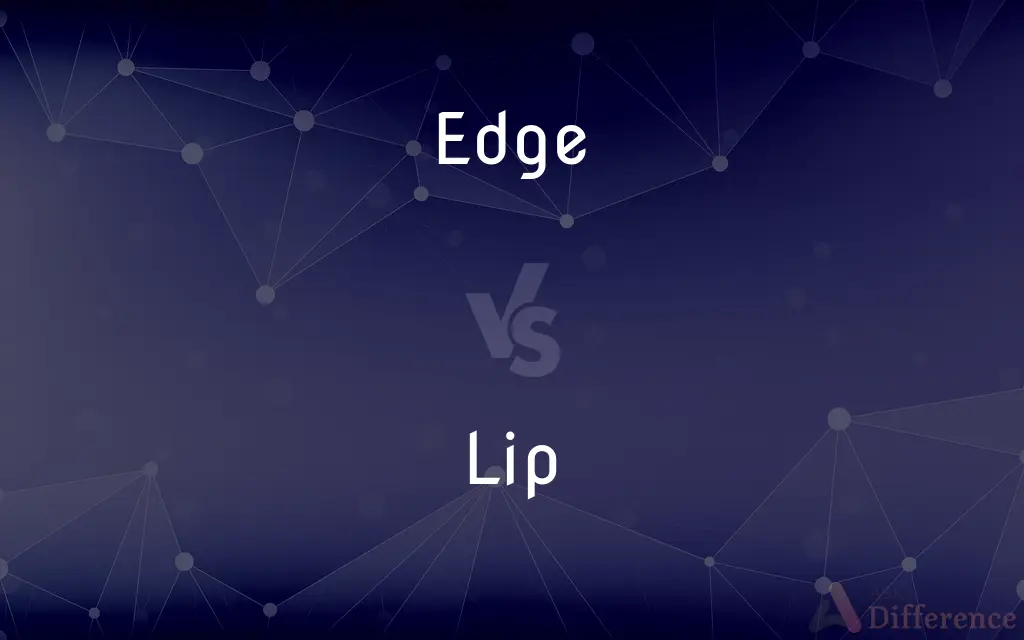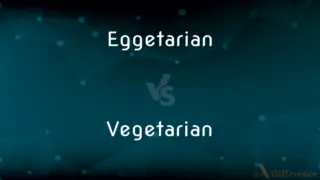Edge vs. Lip — What's the Difference?
By Urooj Arif & Maham Liaqat — Updated on May 3, 2024
The edge refers to the outer boundary or sharp side of an object, often associated with cutting, while the lip is a projecting edge that forms a boundary, especially on containers or openings.

Difference Between Edge and Lip
Table of Contents
ADVERTISEMENT
Key Differences
An edge is typically defined as the sharp side or boundary of an object, tool, or surface, such as the edge of a knife, which is crucial for cutting. On the other hand, a lip refers to the edge of a container or any part that juts out or projects, like the lip of a cup, designed to aid in containing or pouring out contents.
In nature, the edge could describe the point where two different areas meet, such as the edge of a forest or cliff, indicating a clear boundary. Conversely, the lip could describe natural formations like the lip of a volcano or wave, emphasizing the protruding boundary that defines the shape or function of the feature.
In architecture and design, an edge might be used to describe sharp, defined lines that delineate the shape of structures or furniture. In contrast, a lip is often incorporated into designs as a functional feature that enhances usability or aesthetic, such as the lip on a shelf that prevents items from falling off.
When discussing safety and tactile perception, edges are often considered potential hazards due to their sharpness or steep drop-offs, requiring caution. Meanwhile, lips are typically designed to provide a barrier or guide, such as on a ramp or overhang, enhancing safety and accessibility.
In tools and machinery, the edge is a critical feature for performance, particularly in blades and cutting surfaces, where sharpness determines efficiency. On the flip side, lips are important in machinery and containers where seals or secure closures are necessary, like the lip of a jar lid that ensures it closes tightly.
ADVERTISEMENT
Comparison Chart
Definition
The sharp side or boundary of an object.
A projecting edge that forms a boundary.
Common Uses
Cutting, separating, delineating areas.
Containing, pouring, preventing spillage.
Examples
Edge of a knife, edge of a table.
Lip of a cup, lip of a volcano.
Associated Risks
Sharpness can cause cuts, falls.
Minimal risk, often enhances safety.
Design Implication
Important for functionality in tools.
Functional and aesthetic in containers.
Compare with Definitions
Edge
The boundary or sharper part of an object, often associated with cutting.
He carefully sharpened the edge of the blade.
Lip
A rim or edge for holding, pulling, or securing.
The lid’s lip made it easy to open the jar.
Edge
A line where two surfaces meet.
The artist accentuated the edges in the painting for more depth.
Lip
A sharp or abrupt edge in geology or on a wave.
Surfers look for the perfect lip of the wave to perform tricks.
Edge
A competitive advantage.
Her extensive research gave her an edge in the debate.
Lip
The projecting edge of a hollow object or opening.
The cup had a chip on its lip.
Edge
The brink or verge of something.
They camped at the edge of the canyon.
Lip
The upper or lower fleshy part of the mouth.
She applied lipstick on her lip carefully.
Edge
The point at which something is likely to begin.
He was on the edge of discovering something new.
Lip
An edge designed to improve grip or handling.
The suitcase features a sturdy lip for easier lifting.
Edge
The outside limit of an object, area, or surface
She perched on the edge of a desk
A willow tree at the water's edge
Lip
Lips are a visible body part at the mouth of many animals, including humans. Lips are soft, movable, and serve as the opening for food intake and in the articulation of sound and speech.
Edge
The sharpened side of the blade of a cutting implement or weapon
A knife with a razor-sharp edge
Lip
Either of two fleshy structures that surround the opening of the mouth in humans and other mammals.
Edge
A quality or factor which gives superiority over close rivals
His cars have the edge over his rivals'
Lip
In humans, the smooth brownish to reddish border of the lip.
Edge
Provide with a border or edge
The pool is edged with paving
Lip
(Anatomy) A labium.
Edge
Move or cause to move gradually or furtively in a particular direction
Hazel quietly edged him away from the others
She tried to edge away from him
Lip
The margin of flesh around a wound.
Edge
Give an intense or sharp quality to
The bitterness that edged her voice
Lip
Either of the margins of the aperture of a gastropod shell.
Edge
Strike (the ball) with the edge of the bat; strike a ball delivered by (the bowler) with the edge of the bat
Haynes edged to slip
He edged a ball into his pad
Lip
A rim, as of a vessel, bell, or crater.
Edge
Ski with one's weight on the edges of one's skis
You will be edging early, controlling a parallel turn
Lip
(Botany) One of the two divisions of a bilabiate corolla or calyx, as in the snapdragon, or the modified median petal of an orchid flower.
Edge
A thin, sharpened side, as of the blade of a cutting instrument.
Lip
The tip of a pouring spout, as on a pitcher.
Edge
The degree of sharpness of a cutting blade.
Lip
(Slang) Insolent talk.
Edge
A penetrating, incisive quality
"His simplicity sets off the satire, and gives it a finer edge" (William Hazlitt).
Lip
To touch the lips to.
Edge
A slight but noticeable sharpness, harshness, or discomforting quality
His voice had an edge to it.
Lip
To kiss.
Edge
Keenness, as of desire or enjoyment; zest
The brisk walk gave an edge to my appetite.
Lip
To utter.
Edge
The line or area farthest away from the middle
Lifted the carpet's edge.
Lip
To lap or splash against.
Edge
The line of intersection of two surfaces
The edge of a brick.
Lip
(Sports) To hit a golf ball so that it touches the edge of (the hole) without dropping in.
Edge
A rim or brink
The edge of a cliff.
Lip
(countable) Either of the two fleshy protrusions around the opening of the mouth.
Edge
The point at which something is likely to begin
On the edge of war.
Lip
(countable) A part of the body that resembles a lip, such as the edge of a wound or the labia.
Edge
A margin of superiority; an advantage
A slight edge over the opposition.
Lip
The projecting rim of an open container; a short open spout.
Edge
To give an edge to (a blade); sharpen.
Lip
Backtalk; verbal impertinence.
Don’t give me any lip!
Edge
To tilt (a ski or both skis) in such a way that an edge or both edges bite into the snow.
Lip
The edge of a high spot of land.
Edge
To put a border or edge on
Edged the quilt with embroidery.
Lip
The sharp cutting edge on the end of an auger.
Edge
To act as or be an edge of
Bushes that edged the garden path.
Lip
(botany) One of the two opposite divisions of a labiate corolla.
Edge
To advance or push slightly or gradually
The dog edged the ball with its nose.
Lip
(botany) The distinctive petal of the Orchis family.
Edge
To trim or shape the edge of
Edge a lawn.
Lip
(zoology) One of the edges of the aperture of a univalve shell.
Edge
To surpass or beat by a small margin. Often used with out
The runner edged her opponent out at the last moment.
Lip
Embouchure: the condition or strength of a wind instrumentalist's lips.
Edge
To move gradually or hesitantly
The child edged toward the door.
Lip
(transitive) To touch or grasp with the lips; to kiss; to lap the lips against (something).
Edge
The boundary line of a surface.
Lip
(of something inanimate) To touch lightly.
Edge
(geometry) A one-dimensional face of a polytope. In particular, the joining line between two vertices of a polygon; the place where two faces of a polyhedron meet.
Lip
To wash against a surface, lap.
Edge
An advantage.
I have the edge on him.
Lip
(intransitive) To rise or flow up to or over the edge of something.
Edge
The thin cutting side of the blade of an instrument, such as an ax, knife, sword, or scythe; that which cuts as an edge does, or wounds deeply, etc.
Lip
(transitive) To form the rim, edge or margin of something.
Edge
A sharp terminating border; a margin; a brink; an extreme verge.
The cup is right on the edge of the table.
He is standing on the edge of a precipice.
Lip
(transitive) To utter verbally.
Edge
Sharpness; readiness or fitness to cut; keenness; intenseness of desire.
Lip
(transitive) To simulate speech by moving the lips without making any sound; to mouth.
Edge
The border or part adjacent to the line of division; the beginning or early part (of a period of time)
In the edge of evening
Lip
(sports) To make a golf ball hit the lip of the cup, without dropping in.
Edge
(cricket) A shot where the ball comes off the edge of the bat, often unintentionally.
Lip
To change the sound of (a musical note played on a wind instrument) by moving or tensing the lips.
Edge
(graph theory) A connected pair of vertices in a graph.
Lip
One of the two fleshy folds which surround the orifice of the mouth in man and many other animals. In man the lips are organs of speech essential to certain articulations. Hence, by a figure they denote the mouth, or all the organs of speech, and sometimes speech itself.
Thine own lips testify against thee.
Edge
The point of data production in an organization (the focus of edge computing), as opposed to the cloud.
Lip
An edge of an opening; a thin projecting part of anything; a kind of short open spout; as, the lip of a vessel.
Edge
(transitive) To move an object slowly and carefully in a particular direction.
He edged the book across the table.
The muggers edged her into an alley and demanded money.
Lip
The sharp cutting edge on the end of an auger.
Edge
(intransitive) To move slowly and carefully in a particular direction.
He edged away from her.
Lip
One of the two opposite divisions of a labiate corolla.
Edge
(usually in the form 'just edge') To win by a small margin.
Lip
One of the edges of the aperture of a univalve shell.
Edge
To hit the ball with an edge of the bat, causing a fine deflection.
Lip
Impudent or abusive talk; as, don't give me any of your lip.
Edge
(transitive) To trim the margin of a lawn where the grass meets the sidewalk, usually with an electric or gas-powered lawn edger.
Lip
To touch with the lips; to put the lips to; hence, to kiss.
The bubble on the wine which breaksBefore you lip the glass.
A hand that kingsHave lipped and trembled kissing.
Edge
(transitive) To furnish with an edge; to construct an edging.
Lip
To utter; to speak.
Edge
To furnish with an edge, as a tool or weapon; to sharpen.
Lip
To clip; to trim.
Edge
(figurative) To make sharp or keen; to incite; to exasperate; to goad; to urge or egg on.
Lip
Fleshy folds of tissue as those surrounding the mouth
Edge
To delay one's orgasm so as to remain almost at the point of orgasm.
Lip
An impudent or insolent rejoinder;
Don't give me any of your sass
Edge
The thin cutting side of the blade of an instrument; as, the edge of an ax, knife, sword, or scythe.
He which hath the sharp sword with two edges.
Slander,Whose edge is sharper than the sword.
Lip
The top edge of a vessel
Edge
Any sharp terminating border; a margin; a brink; extreme verge; as, the edge of a table, a precipice.
Upon the edge of yonder coppice.
In worst extremes, and on the perilous edgeOf battle.
Pursue even to the very edge of destruction.
Edge
The border or part adjacent to the line of division; the beginning or early part; as, in the edge of evening.
Edge
To furnish with an edge as a tool or weapon; to sharpen.
To edge her champion's sword.
Edge
To shape or dress the edge of, as with a tool.
Edge
To furnish with a fringe or border; as, to edge a dress; to edge a garden with box.
Hills whose tops were edged with groves.
Edge
To make sharp or keen, figuratively; to incite; to exasperate; to goad; to urge or egg on.
By such reasonings, the simple were blinded, and the malicious edged.
Edge
To move by little and little or cautiously, as by pressing forward edgewise; as, edging their chairs forwards.
Edge
To move sideways; to move gradually; as, edge along this way.
Edge
To sail close to the wind.
I must edge up on a point of wind.
Edge
The boundary of a surface
Edge
A sharp side formed by the intersection of two surfaces of an object;
He rounded the edges of the box
Edge
A line determining the limits of an area
Edge
The attribute of urgency;
His voice had an edge to it
Edge
A slight competitive advantage;
He had an edge on the competition
Edge
A strip near the boundary of an object;
He jotted a note on the margin of the page
Edge
Advance slowly, as if by inches;
He edged towards the car
Edge
Provide with a border or edge;
Edge the tablecloth with embroidery
Edge
Lie adjacent to another or share a boundary;
Canada adjoins the U.S.
England marches with Scotland
Edge
Provide with an edge;
Edge a blade
Common Curiosities
How does a lip function on a container?
A lip on a container helps to contain the contents, prevent spills, and sometimes secure a lid or cover.
Where might one typically find an edge used in everyday items?
Edges are commonly found in tools like knives, scissors, and other cutting implements.
Can the term 'lip' refer to part of the human body?
Yes, 'lip' commonly refers to the fleshy outer parts of the mouth in humans and animals.
How do edges affect the performance of sports equipment?
In sports equipment, edges can affect performance, such as the edges of skis or skate blades, which need to be precisely maintained for optimal control.
What is an edge?
An edge is the sharper boundary of an object or surface, often designed for cutting or delineating spaces.
Are edges always sharp?
Not all edges are sharp; some are simply the boundaries of an object or area without being honed for cutting.
What is a lip?
A lip is a projecting edge that forms a boundary, particularly on containers or openings, often used to aid in pouring or securing contents.
Can lips be a feature in architecture?
Yes, lips can be designed into architectural features for both functionality and aesthetic appeal, such as preventing items from slipping off surfaces.
What safety considerations are there with lips on machinery?
Lips on machinery are often designed to ensure secure closing and safety, like the lip of a car door or the seal of a press machine.
What design advantages do edges provide?
Edges can enhance the functionality of a tool, contribute to the aesthetics of a design, and clearly define spatial or visual boundaries.
What are the differences in maintenance for edges and lips?
Edges, especially sharp ones, may require regular sharpening and care to maintain their effectiveness, while lips need regular cleaning to ensure they function properly.
Is the lip of a cup considered a safety feature?
Yes, the lip of a cup can be considered a safety feature as it helps prevent spillage and makes drinking easier.
What architectural elements use edges?
Architectural elements like cornices, edges of roofs, and window frames use edges to define shapes and ensure structural integrity.
How does the edge of a knife differ from the edge of a cliff?
The edge of a knife is designed for cutting and precision, whereas the edge of a cliff represents a boundary or limit that poses safety risks.
How can the lip of a wave be described in surfing terms?
In surfing, the lip of the wave is the part that breaks and curls over, offering opportunities for tricks and maneuvers.
Share Your Discovery

Previous Comparison
Dramatise vs. Dramatize
Next Comparison
Eggetarian vs. VegetarianAuthor Spotlight
Written by
Urooj ArifUrooj is a skilled content writer at Ask Difference, known for her exceptional ability to simplify complex topics into engaging and informative content. With a passion for research and a flair for clear, concise writing, she consistently delivers articles that resonate with our diverse audience.
Co-written by
Maham Liaqat















































